Trees Birds Mammals Fish Amphibians Reptiles
Wild Algarve
Bookshop
Parasola plicatilis (Curtis) Redhead, Vilgalys & Hopple - Pleated Inkcap
Phylum: Basidiomycota - Class: Agaricomycetes - Order: Agaricales - Family: Psathyrellaceae
Distribution - Taxonomic History - Etymology - Identification - Culinary Notes - Reference Sources
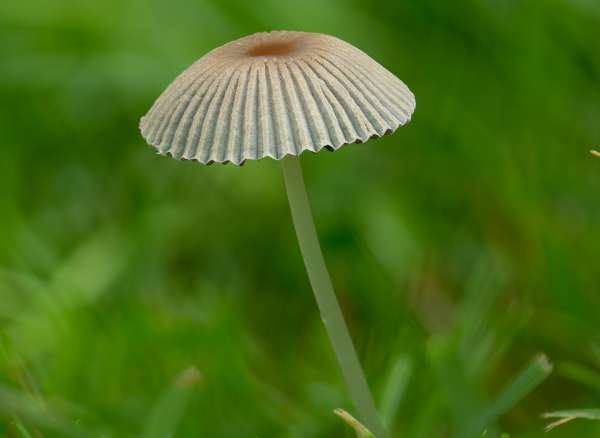
Commonly referred to as the Pleated Inkcap, and sometimes
as the Little Japanese Umbrella, Parasola (formerly Coprinus) plicatilis is a very
delicate member of the inkcap group of fungi. It occurs in short grass.
This is one of the many short-lived grassland fungi that appear overnight following rain; the fruitbodies develop, expand, shed their spores and decay within 24 hours and by the next morning there is usually no evidence of them ever having existed.
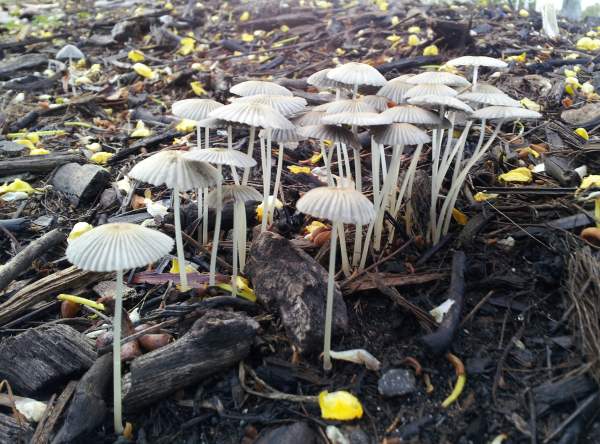
Distribution
Common and widespread in Britain and Ireland, this little mushroom is found also throughout mainland Europe as well as in many other parts of the world including North America. If you have a lawn and you don't smother it in weedkillers and fertilisers, this is one of the little mushrooms that you are likely to see there in summer and autumn. You need to get up early in the morning to see Parasola plicatilis at its very best, because by afternoon the stem usually begins to collapse under the weight of the darkening cap.
Taxonomic history
This Inkcap was first described scientifically in 1777 by British mycologist William Curtis (1746 - 1799), who named it Agaricus plicatilis. (At that time most gilled fungi were initially placed in the genus Agaricus, which has since been largely redistributed across many newer genera.)
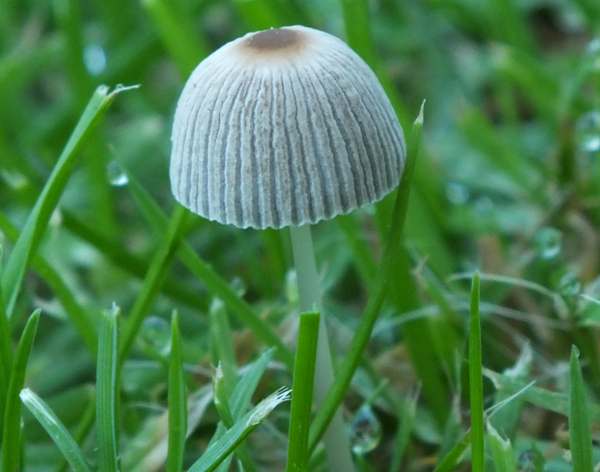
In 1838 the great Swedish mycologist Elias Magnus Fries transferred this species to the genus Coprinus where, as Coprinus plicatilis, it resided undisturbed for the best part of two centuries. In 2001, based on DNA sequencing, Redhead, Vilgalys & Hopple redistributed most of the species formerly collected in the Coprinus genus. The Pleated Parasol was moved to the genus Parasola along with a great many superficially similar little mushrooms, and so its scientific name became Parasola plicatilis. (A microscope is essential to separate the various Parasola species with certainty; even then it is no task for a beginner.)
Synonyms of Parasola plicatilis include Agaricus plicatilis Curtis, and Coprinus plicatilis (Curtis) Fr.
Etymology
The specific epithet plicatilis means pleated - a reference to the grooved upper surface of the cap.
Identification guide
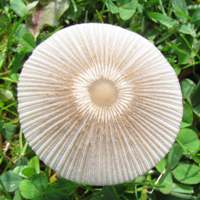 |
Cap
The cap of Parasola plicatilis has a
diameter of 1 to 2cm, is heavily ribbed, and initially egg-shaped, then
convex and finally flat.
A distinctive tawny central 'eye' contrasts with the rest of the pale
grey cap. |
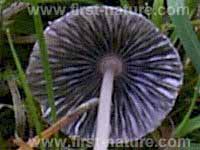 |
Gills
The white gills turn grey and then black;
they radiate from a position just remote from a collar around the top of the stem (unlike those of Parasola auricoma, which are adnate or adnexed to the stem itself), and they are thin and
moderately spaced.
Unlike many of the inkcaps, this delicate little fungus has a cap that
flattens and then shrivels rather than its gills deliquescing (turning
to a black inky liquid). |
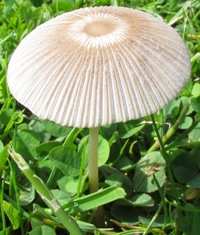 |
Stem
Up to 6cm long, but only 4 or 5mm in diameter, with a slightly swollen base,
and very fragile, the stem of Parasola plicatilis is faintly fibrillose; its colour is white or dingy cream becoming
slightly brownish at the base. |
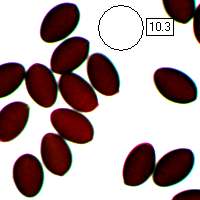 |
Spores
Almond shaped: irregularly ellipsoidal in minor axis cross section and ellipsoidal in major axis cross section, 10-13 x 7-10.5 x 6.5-8μm with an eccentric germ pore - visible in many but not all of the spores pictured here.
Spore print
Black in mass. |
Odour/taste |
Not distinctive. |
Habitat & Ecological role |
Parasola plicatilis is a saprobic mushroom; it appears most often in short grass on lawns and sometimes in
parks and meadows, usually in small groups, but occasionally these little mushrooms produce impressive troops on soil covered in leaf litter and woodchip. |
Season |
May to November in Britain and Ireland. |
Similar species |
Parasola auricoma is slightly larger and darker in cap colour; it has minute hairs among its cap cells, and it grows in woodland habitats and on woodchip mulch.
Parasola leiocephala has free gills whereas the gill of the more common Parasola plicatilis are joined to a collar around the stem.
Parasola kuehnerii is more orange-brown but is otherwise very
similar in macroscopic appearance to Parasola plicatilis; this species is found mainly on woodland edges. |
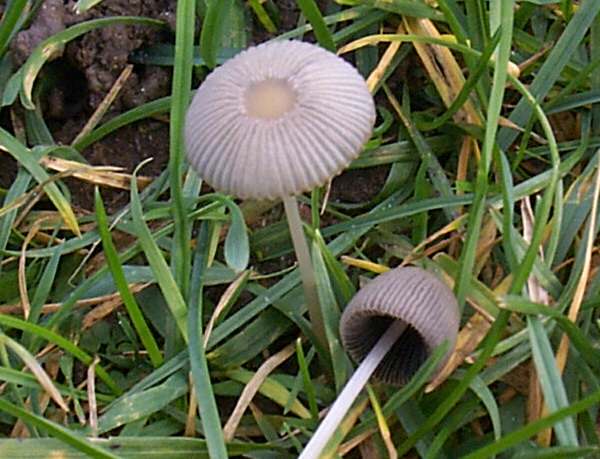
Culinary Notes
The Pleated Inkcap is generally regarded as inedible, and its small size and thin flesh mean that there is little temptation to try eating this insubstantial mushroom.
Reference Sources
Fascinated by Fungi, 2nd Edition, Pat O'Reilly 2016, reprinted by Coch-y-bonddu Books in 2022.
Dictionary of the Fungi; Paul M. Kirk, Paul F. Cannon, David W. Minter and J. A. Stalpers; CABI, 2008
British Mycological Society. English Names for Fungi
Taxonomic history and synonym information on these pages is drawn from many sources but in particular from the British Mycological Society's GB Checklist of Fungi.
Acknowledgements
This page includes pictures kindly contributed by David Kelly (UK) and Patrea Anderson (Australia).
Top of page...
Fascinated by Fungi. Back by popular demand, Pat O'Reilly's best-selling 450-page hardback book is available now. The latest second edition was republished with a sparkling new cover design in September 2022 by Coch-y-Bonddu Books. Full details and copies are available from the publisher's online bookshop...